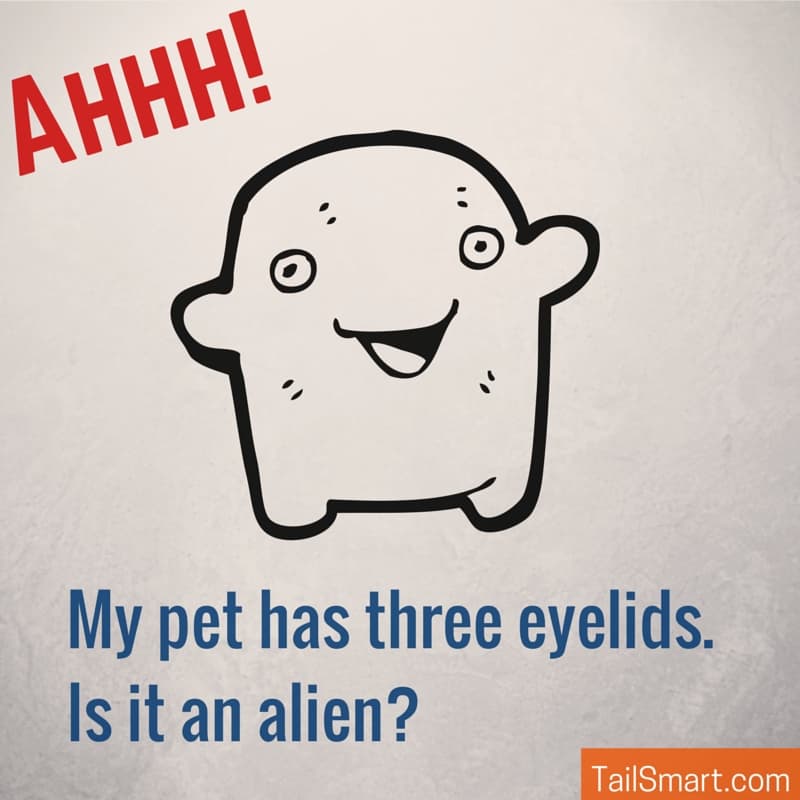
While it is a possibility, it is likely that your pet is just a dog or cat. It turns out that cats and dogs have a third “eyelid,” known as the nictitating membrane. This membrane is usually not seen unless the eye has been pulled back to protect it from pain. So before you start looking for UFOs or wonder where the little green men are, let’s have a look at what this third eyelid could be in more detail.
What is an eyelid and what is it for?
An eyelid is a thin fold of skin set above and below the eye of humans and dogs alike. There are eyelashes attached to the outer edge, and they can open or close as desired. Their primary functions are to keep the eye moist and to protect it from irritations and potential damage. Even though dogs and cats have 3 “eyelids,” the third eyelid is not the same as outer lids.
This third eyelid, the nictitating membrane, is located between the lower eyelid and the eye itself. It does not have eyelashes, moves in a horizontal fashion and is mostly transparent.
Why do cats and dogs have three eyelids?
Cats and dogs have three eyelids for many reasons. These membranes are designed to assist in keeping the eye moist without having to use the outer eyelids which would cause a loss of sight, even if only temporarily. They are also designed to keep the eye clean and clear of any debris that may find its way into the eye. It also protects against potential issues such as running through the forest and are responsible for the production of a third of the tears in your pet’s eye.
These eyelids are not consciously controlled and will appear as needed to protect the eye. Occasionally there are issues such as poor breeding, swelling or eye pain which will cause the membrane to appear. They retract once the threat or pain disappears, however in the case of poor breeding the dog will have a haggard look and may require surgery to correct this.
Some breeds who are prone to “diamond eye,” a condition where the dog suffers both ectropic and entropic eye conditions. This condition is where the eyelid is both turned into the eye at the corners and the middle lower lid sags, exposing the eye permanently. A qualified veterinarian is required for treatment as it will not resolve on its own.
What’s Cherry eye?
Dogs can suffer from a condition where the nictitans gland prolapses, commonly referred to as Cherry Eye. This painful condition usually occurs in dogs less than two years of age yet can occur in dogs and cats of any age and causes the membrane to inflame and swell becoming visible. There are a number of things that may cause this issue; however there is little known about the exact cause.
Certain breeds are significantly more prone to Cherry Eye than others.
Dogs
- Basset Hounds
- Beagle
- Bloodhound
- Boston Terriers
- Boxer
- Cocker Spaniel
- English Bulldog
- Miniature Poodle
- Newfoundland
- Pug
- Shih Tzu
- Saint Bernard
Cats
- Burmese
- Bombay
The above breeds are just some of the breeds prone to this issue, and therefore should be carefully watched when they are younger to ensure they do not end up with this affliction.
Symptoms
The symptoms of cherry eye are hard to miss. There will be a large, bright red mass in the corner of your pet’s eye(s) which can appear overnight. Often your pet will be quite sensitive about anyone or anything around their head as this is quite painful and prone to damage. If you notice your pet has this and they are trying to rub their eye, it is important to try to prevent that as it can cause serious and irreversible damage.
Diagnosis and Treatment
A qualified veterinarian will make their diagnosis via physical examination of the eye. They will also perform a more thorough exam of both eyes to ensure there are no other issues or infections. They will note whether or not tear production is affected and if so, how badly.
Treatment depends on the suspected cause of the cherry eye. Often antibiotics will be prescribed regardless of the cause however these will not reduce the swelling and return the eye to normal. This ailment, unfortunately, is only correctable via surgery. The surgery performed is just to move the gland back to its original location and then stitch it into place. In most breeds, this will usually solve the issue, yet for those prone to recurrence the gland may have to be removed.
Removal of the gland is a last resort as without the gland, the patient will have issues producing enough lubrication for their eye and will require eye drops several times a day for the remainder of their life.